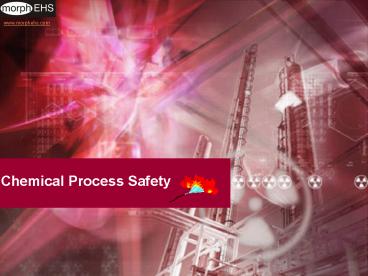Chemical Process Safety - PowerPoint PPT Presentation
1 / 19
Title:
Chemical Process Safety
Description:
Examples: Dow Fire and Explosion Index (F&EI) Dow Chemical Exposure Index (CEI) Case A Case B ... Dow Chemical Exposure Index (CEI) Considers toxic materials only. ... – PowerPoint PPT presentation
Number of Views:485
Avg rating:3.0/5.0
Title: Chemical Process Safety
1
Chemical Process Safety
2
Presentation Outline
- Inherent Safety
- Hazard Identification
- Risk Assessment
- Fire Protection
3
Inherently Safer Processes
Reduction or elimination of the hazards
associated with a process, and this reduction or
elimination is permanent and inseparable from the
process. Example use a less toxic raw material
to product a product.
4
Inherently Safer Process Methods
Minimize Reduce quantity of energy in
process. Substitute Use less hazardous raw
materials. Moderate Use lower temperatures and
pressures. Simplify Reduce unnecessary
complexity in the design and operation. KISS
Keep it simple and safe!
5
Hazard Identification/ Risk Assess Procedure
HAZARD IDENTIFICATION METHODS - Process
hazard checklist - Hazard survey DOW
index - HAZOP hazard operability study
- Safety review
RISK ASSESSMENT - What can go wrong how
? - What are the chances ? -
Consequences ?
EXTREMES - Low probability -
Minimal consequences
6
Hazard Identification
Why? To identify hazards so that they can be
eliminated or controlled. How? Using a number of
available procedures.
7
Relative Ranking Methods
Provide a unit less number representing the
relative hazard. Examples Dow Fire and Explosion
Index (FEI) Dow Chemical Exposure Index (CEI)
Case A gt Case B
8
Dow Fire and Explosion Index
- Operates like an income tax form.
- Penalties for unsafe situations
- Credits for control and mitigation
- Produces a number - the bigger the number the
greater the hazard. - Only considers flammable materials
- Not effective for procedures.
9
Dow Chemical Exposure Index (CEI)
- Considers toxic materials only.
- Includes simple source and dispersion models.
- Not effective for procedures.
Dow Criteria If sum of FEI and CEI gt 128, then
more detailed hazard review procedure required.
10
Hazard and Operability Studies (HAZOP)
- Can identify hazards due to fixed equipment and
procedures. - Is a huge effort.
- Provides a controlled mechanism to consider the
things that can go wrong. - Customized for each company.
- Improves process performance, quality, etc.
11
HAZOP Procedure - 1
1. Divide flow sheet into sections, i.e. reactor,
storage. 2. Choose a study node, i.e. line,
vessel, pump, operating instruction. 3.
Describe its design intent. 4. Select a process
parameter. 5. Apply a guide word. 6. Determine
cause(s).
12
HAZOP Procedure - 2
7. Evaluate consequences/problems. 8. Recommend
action what? who? when? 9. Record
info. 10. Repeat 5 to 9 for a new guide word. 11.
Repeat 4 to 10 for a new process parameter. 12.
Repeat 2 to 11 for a new study node. 13. Repeat 1
to 12 for a new flow sheet section.
13
HAZOP Summary
Advantages Meets regulatory requirements Pla
nt operates better Less down time Product
quality improved Employees are
happier Disadvantages Time, people and
effort Information management problem
14
Fire Protection
Problem How to safely store flammable liquids
and gases to prevent fires and explosions? Primary
Design Objective Prevent fires and explosions
by preventing the existence of flammable
mixtures. Secondary Design Objective Reduce or
eliminate ignition sources.
Remove this leg Reduce this leg
Oxidant
Fuel
Ignition Source
15
Design Objective Prevent Flammable Mixtures
(1) Fuel (z) Oxygen ---gt Products
100
0
Fuel
Oxygen
UFL
Flammable
LFL
100
0
100
0
Nitrogen
16
Taking a Vessel Out of Service - 1
Start here - all fuel
100
0
Depressurize vessel to atmospheric, then blow air
into vessel.
Air Line
Fuel
Oxygen
UFL
Flammable
LFL
100
0
100
0
Nitrogen
End here (all air)
17
Taking a Vessel Out of Service - 2
(1) Fuel (z) Oxygen ---gt Products
Add nitrogen to reduce fuel concentration.
18
Most Important Point
Chemicals used in chemical plants may be
hazardous, but if you understand these hazardous
properties and understand how they may cause
accidents, then the chemicals can be handled
safely.
19
S-A-F-E-T-Y
- S - Management Systems
- A - Proper Attitude
- F - Understand Fundamentals
- E - Experience
- T - Time to do things safely
- Y - Your Participation































